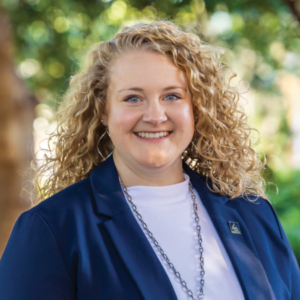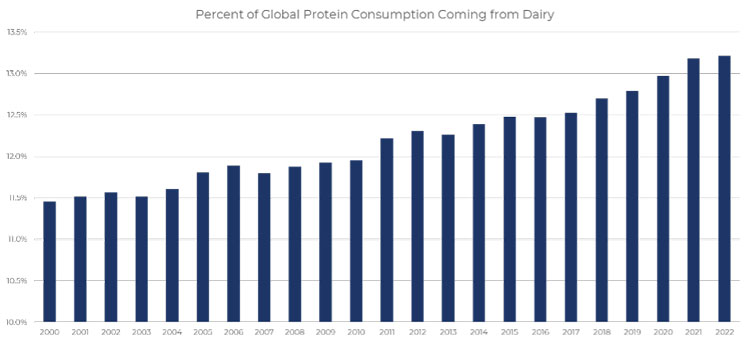NMPF Executive Vice President of Communications & Industry Relations Alan Bjerga speaks on WEKZ Radio, Janesville, WI, about the resumption of USDA’s Federal Milk Marketing Order hearing in Carmel, IN, next week. The hearing, which was originally expected to last until mid-October, may now slip into 2024. Scheduling issues and unexpected confrontations are pushing back the timeline for the necessary modernization many farmers are hoping can take effect to help their operations thrive, Bjerga said.
Tag: dairy industry
NMPF’s Doud Discusses Dairy’s Future
Incoming NMPF President & CEO Gregg Doud explains NMPF’s role in Washington policy formulation and dairy farmer priorities, including a new farm bill, Federal Milk Marketing Order modernization, integrity in plant-based labeling and dietary guidelines that maximize the benefits of dairy, in an interview with RFD-TV. He also emphasized the importance of international trade and global issues to U.S. dairy’s future. “We need to look five, 10 years ahead and see what this industry needs,” he said.
Lights, camera … Bjerga! Live from the Dairy Experience
NMPF Executive Vice President for Communications & Industry Relations Alan Bjerga takes viewers on a tour of the Dairy Experience at this week’s Joint Annual Meeting in Orlando, FL. From information booths to ice cream, this year’s event brought together a diverse dairy community, showing farmer unity and industry pride during a time of transition at NMPF.
Dairy is a staple in spite of inflation
By Allison Wilton, Coordinator, Economic Policy and Global Analysis, NMPF
 U.S. dairy consumption has been steadily rising for years, reaching more than 11.5 million metric tons (milk solids equivalent) in 2022. This is up 15% from ten years ago. As one of the highest dairy consuming countries in the world, U.S. per capita consumption of cheese, yogurt, and butter has grown steadily for years. Recent food trends are bringing fun and innovative twists on common dairy products; as examples, butter boards went viral last year as a new “charcuterie” option, and health influencers are raving about the benefits of adding cottage cheese into recipes for higher protein and healthy fats. Ultimately, dairy demand remains resilient even when facing significant headwinds.Dairy’s resiliency is true on a global basis, too. On average, 13% of the global consumer’s protein came from dairy in 2022, a rise compared to 2021 and a significant leap over the past decade. In fact, global dairy protein consumption has grown by nearly 25% over the last decade.
U.S. dairy consumption has been steadily rising for years, reaching more than 11.5 million metric tons (milk solids equivalent) in 2022. This is up 15% from ten years ago. As one of the highest dairy consuming countries in the world, U.S. per capita consumption of cheese, yogurt, and butter has grown steadily for years. Recent food trends are bringing fun and innovative twists on common dairy products; as examples, butter boards went viral last year as a new “charcuterie” option, and health influencers are raving about the benefits of adding cottage cheese into recipes for higher protein and healthy fats. Ultimately, dairy demand remains resilient even when facing significant headwinds.Dairy’s resiliency is true on a global basis, too. On average, 13% of the global consumer’s protein came from dairy in 2022, a rise compared to 2021 and a significant leap over the past decade. In fact, global dairy protein consumption has grown by nearly 25% over the last decade.

Still, despite that resiliency, inflation and economic uncertainty have affected consumers and the dairy industry.
Inflation had mixed effects
In 2022, consumers started to really take notice of rising grocery and food costs. Prices for goods across all categories, not just dairy, were starting to climb more than usual due to several factors, including the ongoing COVID-19 pandemic and international supply chain disruptions. Inflation reached a peak in summer of 2022, and though it has eased slightly since, prices are still significantly higher compared to three years ago.

Source: NMPF-USDEC, IRI, NPD
Grocery and food items were some of the most prevalent and hardest hit areas by inflation, and dairy products were not immune. The price of dairy in food and beverage stores rose by more than 15% in 2022 compared to 2021, the highest jump in prices of all categories. The value of dairy sales grew significantly in 2022. Even so, and although this can partially be attributed to the higher prices, the growth in dairy sales (up 14.7%) outpaced that of non-dairy categories (8.3% greater).
Additionally, though all categories’ volume fell, the volume of dairy products sold fell less than that of non-dairy products. In other words: even though dairy had higher inflation rates, the slide in volume sold was less than the dip of other food and beverage categories. Shoppers were continuing to put dairy products in their cart despite the higher prices. That’s a testament to the dairy’s place as a dietary staple for many around the country and the world.
Dairy demand persists
Consumers prefer dairy products over plant-based alternatives: sales of cheese, frozen products, and other dairy goods dwarf plant-based imitations in stores. As even more alternatives fill shelves, dairy doesn’t lose shelf space. Rather, per capita consumption in several areas have grown, including cheese (up 17% from 2020), yogurt (up 5%), and butter (up 21%). The dairy aisle remains of top value when compared to other aisles within major food and beverage stores and is one of the fastest growing aisles in terms of sales dollars, topping $75 billion in 2022.
Cheese is expected to grow only more popular as time goes on, as is butter and yogurt. The U.S. dairy industry is poised to meet this demand as the industry advances in the coming years. As inflation wanes, consumers may return to trying higher value dairy products, of which there is no shortage. U.S. dairy will continue to be a major part of consumers’ diets and shopping carts.
This column originally appeared in Hoard’s Dairyman Intel on Nov. 9, 2023.
Preview of Upcoming NMPF 2023 Annual Meeting in Orlando
NMPF’s senior vice president Chris Galen discusses the upcoming 2023 NMPF annual meeting starting Nov. 12 in Florida.
NMPF’s Bjerga on Perceptions of Dairy, Agriculture in Wartime
NMPF Executive Vice President Alan Bjerga discusses how agriculture and food thought leaders perceived dairy during his recent participation in the World Food Prize in Des Moines, IA, detailing some of the misconceptions found on dairy’s sustainability and role in food security. He also discusses the challenges farmers are facing in conflict zones, including recent attacks in Israel and the ongoing war in Ukraine, in an interview with WEKZ Radio.
NMPF’S Morris Reviews Achievements of International Dairy Federation Summit
Shawna Morris, NMPF’s executive vice president of trade policy, discusses the recent International Dairy Federation world summit held in Chicago in this audio segment from Dairy Radio Now.
USDEC’s Harden discusses USDA Support for Trade
Krysta Harden, president and CEO of the U.S. Dairy Export Council, discusses the value of USDA support for U.S. agricultural exports in an interview with RFD-TV from the World Food Prize in Des Moines, IA. The department said Oct. 24 it plans to devote $2.3 billion from the Commodity Credit Corporation to promoting better market opportunities for U.S. agricultural producers and expanding food aid to support communities in need around the world, a move advocated for by NMPF and USDEC.
NMPF’s Jonker brings the IDF World Dairy Summit home
NMPF Chief Science Officer Jamie Jonker connects the themes of the World Dairy Summit, which concluded in Chicago on Thursday, to advancing the interests of U.S. dairy farmers. The summit, hosted by the United States for the first time since 1994, had attendees from 55 countries and activities from technical panels to farm tours.
NMPF’s Jonker Welcomes the World to U.S. Dairy
NMPF Chief Science Officer Jamie Jonker discusses the International Dairy Federation World Dairy Summit taking place in Chicago this week in an interview with RFD-TV. The summit, which is being hosted by the United States for the first time since 1994, brings together dairy experts from around the world and is proving to be a great showcase for U.S. dairy excellence.
NMPF’s Bjerga on How to Learn More About FMMO
NMPF Executive Vice President for Communications and Industry Relations Alan Bjerga offers an update on where the USDA’s Federal Milk Marketing Order hearing stands as it goes on hiatus until late November. Bjerga also discusses the importance of the IDF-World Dairy Summit in Chicago and where the public can go to learn more about the FMMO discussion, in an interview with WEKZ radio, Janesville, WI.
FMMO Hearing Shows Strength of Co-ops
USDA’s Federal Milk Marketing Order hearing in Carmel, IN, is providing the dairy industry with mountains of valuable information and insight that goes well beyond facts and figures.
The hearing isn’t only about shaping milk pricing; it’s also showing what needs improving in our industry, and it’s an opportunity to demonstrate what keeps dairy strong. And nothing is on display more emphatically than the power of dairy farmers and the cooperatives they own, and the importance of the cooperative structure to future progress in dairy, at all levels of production, processing and marketing.
Our breadth of membership and depth of milk marketing expertise has risen to every occasion during this hearing, relentlessly advancing the consensus proposal we adopted after two years of exhaustive study and discussion.
That plan, the only comprehensive solution that adequately makes the adjustments the FMMO system needs, would not have come about in the first place were we not able to rely on our farmer-cooperative members and staff to lead the industry. And without the unified voice a farmer cooperative provides its members in policy discussions, we never would have been able to achieve the unanimity in our membership that was necessary for USDA to take up our plan at all.
That final point is important. Cooperative membership holds multiple benefits for member-owners, beginning with having a guaranteed market for milk each day, but adding up to much more. Cooperatives provide technical expertise and risk-management assistance. Cooperatives pool supplies and capital, finance exports, enhance farmers’ bargaining position with proprietary processors, and even enable those farmers to become processors themselves.
These benefits have allowed dairy farmers to build multimillion-dollar processing plants in local communities, access needed financial resources, and capitalize on efficiencies in areas like milk hauling. Membership in a cooperative is the best way, and sometimes the only way, for a dairy farmer to get products to market and earn a decent return from doing so. Simply put, cooperatives make farmers stronger.
But for cooperatives to remain strong, they also need their members to actively engage.
That’s why it’s important to always remain vigilant against any effort to weaken cooperatives by limiting their ability to speak with a unified voice or adequately represent the best interests of their members. From time to time we hear of efforts on Capitol Hill or elsewhere to dilute the power of cooperatives to speak with one voice on votes on issues such as the Federal Milk Marketing Order system. Offered under the guise of encouraging individual choice, in practice these efforts are more like “divide and conquer” – chipping away at the benefits cooperatives provide by weakening their ability to pursue their members’ best interests.
Such efforts tend to be pursued by the same interests that, in the end, would rather that co-ops go away: companies that would prefer the benefits (to them) of vertical integration; agribusinesses that would rather not bargain with co-ops to get a better price for farmers; individual farmers who don’t feel they “need” co-ops to succeed (even as they buy inputs and sign contracts with them); and political ideologues who just don’t like the idea of farmers helping one another for mutual benefit. We’ve always been able to successfully resist them because, in the end, we use the very power we have to work together and protect our members’ interests.
As we celebrate October as National Co-op Month, with Farm Bill discussions underway and FMMO modernization making its way toward an eventual producer vote, we stand ever ready to defend cooperatives and their principles. Every day, at the federal order hearing in Indiana, we’re proving just how valuable to dairy the cooperative model remains. And every day across America, on farms, in milk trucks and in supermarkets, we remain proud of all we do to facilitate orderly marketing of milk and keep this nation nourished – and will continue to do so, with a strong, united voice, for many years to come.
Jim Mulhern
President & CEO, NMPF






